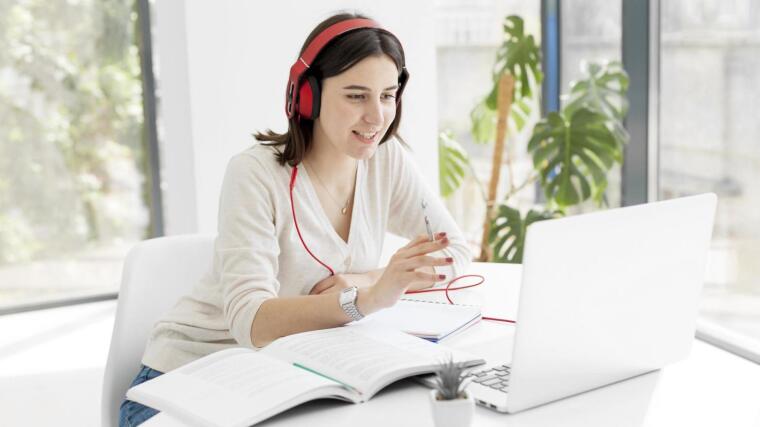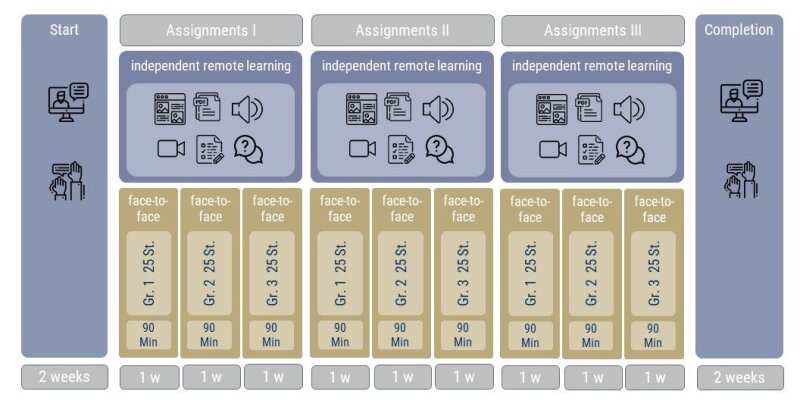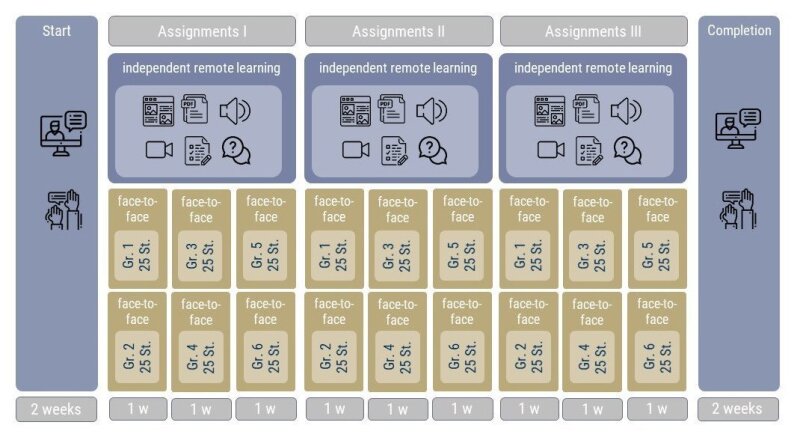
Overview
This example is based on the concept of the flipped classroom teaching strategy and consistently interweaves phases of independent remote learning with periods of face-to-face teaching.
During the independent remote learning phase students work through task packages given to them by the instructor. Depending on the learning objective of the course these can be audio-/ screencasts, texts or scripts, or tasks that have to be completed by the students. The fundamentals of the course content – traditionally presented within the context of a regular course session – are thus outsourced and acquired through students’ independent remote learning.
In contrast, the face-to-face sessions are dedicated to deepening knowledge and to tasks requiring application or transfer of the knowledge or skills acquired. They enable you as the instructor to get an insight into where your students stand in regard to their learning, to become aware of obstacles or difficulties, and to manage these together with your students. For students, these appointments are an opportunity to ask questions that have arisen over the course of their independent online learning. Important to note: the in-person-appointments offer a space for interaction and discussion. You should expect the completion of the allotted tasks as a given and go far beyond a mere repetition of aspects of knowledge previously acquired during students’ independent online learning.
Start - online and with all students enrolled in this course
- Takes place synchronously via web conference i.e. zoom - duration ca 90mins
- Determination of students’ level of knowledge and competence: e.g. assessing prior knowledge via an audience-response-system (e.g. pingoExternal link), a gathering of hypotheses or ideas on the topic of the course, or through creating an inventory of knowledge on a virtual pinboard (e.g. PadletExternal link)
- Introduction to different ways of working (course concept and structure); if applicable: preparation of dividing students into break out groups for the individual sessions
- Making students’ expectations transparent: which learning objectives are you pursuing in this course? How can/should all students participate? (When) should webcams/microphones be switched on during web conferences? How can technical difficulties be dealt with? What is due to be prepared for individual sessions? When, how, and on basis of which criteria is performance assessed and marked?
- Independent online-learning period: Content schedule and central idea of the course; arouse interest in the topic, e.g. via the usage of case studies/examples, through referencing your discipline’s challenges, making connections to students’ everyday environment; linking to and going beyond students’ points of prior knowledge e.a.
Assignment Packages I-III - alternating face-to-face group sessions
- in our example each task package consists of a three-week independent online-learning period plus three in-person sessions with a different group each (with a maximum of 25 students per group). To this end, all students participating in the course are grouped into three roughly similarly sized groups; each group is allocated one in-person appointment per assignment package.
- Independent online-learning period: students acquire new knowledge, actively digest it and/or solve problems; this process could be based on recorded input, screencasts, self-study-videos, scripts, texts, research-and/or writing assignments for the students (e.g. via moodle: wiki or peer-review)
- In-person group session: Each group receives at least one consultation appointment per task package between 45 and 90 minutes in duration, depending on group size (see diagram); these in-person sessions are meant to answer questions or lead to a more in-depth discussion of selected topics, for the assessment of knowledge and competences gained during self-study through a joint working through (transfer-) tasks or the gathering of ideas towards a solution; furthermore, it is advisable to discuss mistakes that hinder students’ further completion of the assignment.
- Organizational challenge: each group participates in the in-person session at a different point in time which means they might be at different points of the assignment process at the time of the session.
- Possible solution 1) Perhaps you can make the first task package available to students even prior to starting the entire process – that way the first group has more time to work on it.
- Possible solution 2) You can offer shorter weekly in-person group consultations so that each group has more (albeit shorter) sessions to attend.
Competiton - online with all students participating in the course
- takes place synchronously via web conference (e.g. zoom)
- Thematic conclusion of the course, e.g. through a weaving together of the insights gained through the individual task packages
- Discussion of questions that have arisen across the different assignment packages
- Taking stock of acquired knowledge e.g. via mapping it out, for example with PadletExternal link)
- Tune in on upcoming assessments/exams: Sharing information on assessment modalities; giving insight into helpful exam preparation strategies and making the assessment criteria transparent; if applicable: Working on practice questions and subsequently clarifying questions arising during this process.

